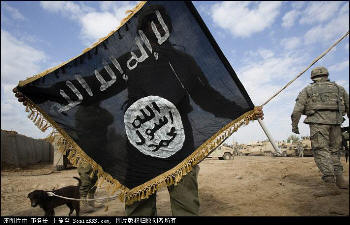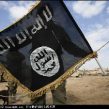
Jihadists Exploit Syrian Turmoil as the Islamic State of Iraq Makes a Comeback
Publication: Terrorism Monitor Volume: 10 Issue: 23
By:

Iraq’s armed Islamist front is beginning to see favorable results from a new phase in the movement’s struggle that began in the summer. The plan, entitled “Demolishing the Walls,” was announced in a July 21 audio message by Abu Bakr al-Qurayshi al-Baghdadi, the Amir of the Islamic State of Iraq (ISI), a Sunni Islamist umbrella group formed in 2006 by al-Qaeda in Iraq. [1] Since last July, the ISI has been able to orchestrate an effective and geographically widespread bombing campaign in regions ranging from Mosul and Kirkuk in the north to Basra and Nasiriya in the south. Targets of the attacks include security checkpoints, government buildings, public places and Shi’a neighborhoods, with a resultant death of scores of civilians.
Although ISI attacks were persistent all over the country well before the announcement of the new campaign, the scale, coordination and impact of the operations carried out after al-Baghdadi’s message are a clear indication of the group’s increased operational capacity since the withdrawal of U.S. forces from Iraq in December 2011. However, the most striking feature of the “Demolishing the Walls” campaign remains the ISI’s ability to launch simultaneous attacks in different cities through a combination of suicide bombings, IEDs, car bombs and armed assaults. The trend suggests that the ISI may be benefiting from the increased freedom of movement across the region generated by the Syrian conflict, with the group exploiting the growing instability along the border with Syria to move militants and weapons (al-Akhbar, July 19, July 27, al-Shorfa, August 27). This, however, is not the main factor behind the ISI’s longevity.
“Demolishing the Walls”
Since its inception, the ISI campaign has followed a steady and constant pattern, with monthly strings of bombings demonstrating the group’s ability to plan and perpetrate attacks. There have been five major waves of coordinated mass-casualty attacks in Iraq between July and September:
- On July 23, the ISI launched 22 attacks in 14 Iraqi cities, killing 91 civilians and wounding 224 others. The attacks, which mainly targeted military centres and police stations, all took place within a two-hour time period. The deadliest strikes occurred in Baghdad, Taji, Dhuluiya, Sadr City, Baqubah and Kirkuk (al-Shorfa, July 23).
- On August 16, the ISI unleashed a second string of major attacks targeting 19 cities, killing over 120 people. As in the first wave, the majority of these attacks hit the Baghdad area, with an armed assault against a military checkpoint in Moshahida resulting in the death of 20 soldiers and a car bomb in Sadr City that killed 65 people (National Iraqi News Agency, August 17).
- On September 9, the ISI expanded the geographic range of its operations with a string of coordinated explosions targeting 18 cities, including Baghdad and Kirkuk and points to the south in Basra, Nassiriya, and Amarah. The attacks killed over 110 people while focusing on important Shi’a symbols. Typical of such attacks was the double car bomb blast near a Shi’a mosque in Amarah. Security facilities such as the Intelligence Department in Kirkuk and foreign assets such as the French consular office in Nassariya were also struck by suicide bombers and car bombs (al-Akhbar, September 9, Aswat al-Iraq, September 10).
- On October 27, a day after Eid al-Adha, the ISI targeted Shi’a worshipers in Tikrit, Mosul, Baghdad and Sadr City, killing dozens (National Iraqi Agency, October 27).
- On November 27, the ISI launched 13 attacks killing 26 people in seven cities (Almada [Baghdad], November 28).
Besides these three major operations, the ISI has been launching other operations in line with the strategic priorities announced by Abu Bakr al-Baghdadi, namely “releasing the Muslim captives everywhere, targeting the supporters and followers of the Safavid Government [a reference to the Shi’a dominated Government of Nuri al-Maliki] and performing jihad against the Safavid rafida [“rejectionists,” a derogatory reference to the Shi’a].” [2] While these operations point to a steady increase in the ISI’s ability not only to stage attacks simultaneously in several cities but also to penetrate into Shi’a southern strongholds, the assault on the Tasfirat Prison in Tikrit on September 27 highlighted both the ISI’s capacity to easily strike the security apparatus and to launch a sophisticated attack against a heavily guarded facility. In the complex assault, which resulted in the liberation of more than 100 prisoners, including dozens of convicted terrorists, ISI militants dressed in police uniforms attacked the prison with silenced weapons, hand grenades, explosive belts and car bombs, coordinating the operations with “the imprisoned brothers inside the jail.” [3] Security forces managed to regain control of the facility only after several hours of clashes in which 12 prison guards were killed, but not before the militants had destroyed all documents, files and pictures of the prisoners (al-Akhbar, September 28).
The Spillover of the Syrian conflict
Iraqi military and intelligence reports have confirmed the death or detention of more than 70 major military commanders or religious authorities working with the Salafist groups so far this year in nation-wide counterterrorism operations (al-Shorfa, September 9). This crackdown, however, does not seem to have had an immediate effect on the ground. U.S. officials suggested in October that since the American withdrawal from the country last year, the ISI has doubled its ranks (now around 2500 fighters) and has established new operational bases in western Iraq, most notably in the provinces bordering Syria (Washington Post, October 9).
The worsening of the Syrian conflict and the increasing porousness of the Syrian-Iraqi border are undoubtedly playing a role in the apparent resurgence of the ISI, lending weight to the hypothesis of a possible correlation between the two developments. Iraqi jihadists were operating in eastern Syria well before the start of the conflict there, as the country was one of the main entry points for foreign jihadists going into Iraq to join al-Qaeda in 2004-2007. Included in their ranks were many Syrians who are now using tactics learned in Iraq against the forces of Bashar al-Assad. The facilitation networks have probably been reactivated and it is not surprising that, in the name of their “jihadist friendship,” Syrian and Iraqi fighters are now working together in the struggle against the “apostate regime” of Damascus.
The arrests of 11 suspected members of al-Qaeda in Iraq in connection with an October plot to mount waves of attacks on targets in Amman Jordan (including the American embassy) using weapons smuggled from Syria and advice from Iraqi explosives experts showed the potential for closer cooperation between jihadists in the region taking advantage of the crisis in Syria (al-Sharq al-Awsat, October 22).
While the steady pattern of violence in Iraq in recent years suggests that the ISI’s ability to launch deadly attacks has never diminished, the group is now benefitting from the Syrian conflict in terms of increased freedom of movement for arms and personnel. For instance, the total number of terrorist attacks in Iraq in 2011 was 1,300, a figure that indicates a noteworthy increase compared with the 1,179 attacks carried out in 2010, when the Syrian conflict had yet to erupt. [4] In the same vein, based on the first nine months of this year the rate of civilian deaths per day from suicide attacks and vehicle bombs is 7.3, a significant upsurge in terrorism-related violence compared with the 6.6 rate observed in 2011. [5]
Conclusion
As the spillover of the Syrian conflict grants more mobility and freedom of action to ISI militants, three other major factors should be included when it comes to explaining the ISI’s increased operational capacity in recent months. First of all, the withdrawal of U.S. combat troops from Iraq cannot be ignored. The withdrawal has left the group without a strong opponent, leaving its militants more room to plot, execute and concentrate their operations. Secondly, the release by the Iraqi Government of dozens of detainees previously held in U.S. custody on terrorism-related charges could have resulted in the influx of veteran jihadists into ISI ranks, bringing their experience and enabling the group’s tactics to become more sophisticated (al-Jazeera, January 18; Jerusalem Post, November 18). Finally, neither the political chaos in Iraq, where there is still no sign of a viable reconciliation process among the various elements of Iraqi society, nor the growing frustration among Sunnis towards the Shi’a-dominated government, can be overlooked in explaining the longevity the ISI is enjoying in the country. These factors combined will likely play a major role in sustaining the ISI offensive in the coming months, as the spillover of the Syrian conflict will clarify whether the ISI remains a threat to Iraqi stability only, or whether the movement will become a regional menace. Should the Assad regime collapse and the jihadist groups consolidate their foothold in Syria, a closer and more formal cooperation between militants in both countries cannot be excluded, with ISI presenting itself once more as a point of reference for jihadists in the area and able to use Syria to expand its operations.
Notes
1. Abu Bakr al Qurayshi al-Baghdadi, “But God will not allow except that his light should be,” https://www.shamikh1.info/vb/showthread.php?t=172116.
2. Ibid.
3. Islamic State of Iraq Statement, “On the prison raid at Tasfirat Tikrit,” https://www.shamikh1.info/vb/showthread.php?t=180410.
4. Data drawn from Global Terrorism Database (GTD), University of Maryland, https://www.start.umd.edu/gtd/.
5. Data drawn from Iraqi Body Count, https://www.iraqbodycount.org/database/.





